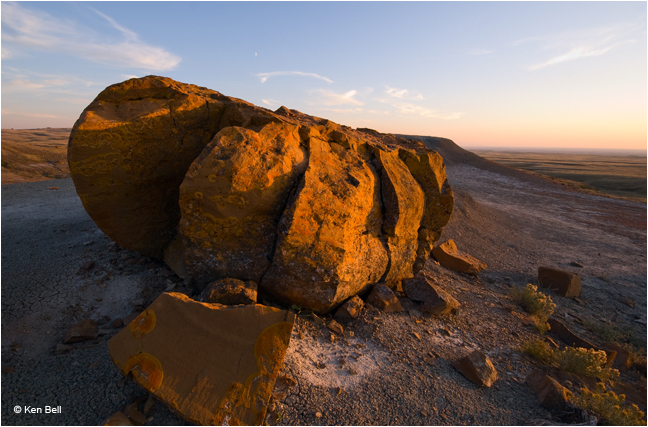
Red Rock CouleeBy Ken Bell
Red Rock Coulee is a nature area occupying about 325 hectares of land southwest of Medicine Hat. From Medicine Hat take highway 3 west to highway 887, just before the hamlet of Seven Persons. Go south on highway 887 26 Km then at a large curve in the road watch for the signs indicating the coulee, which is on a side road going straight south from the curve. There is a parking area on top of the hill where you can begin to explore the area. Note that this is a primitive nature area, so other than a few picnic tables there are no other accommodations. Open fires are not permitted.
Dirt road runs straight off highway 887 into Red Rock Coulee about 500 meters ahead
Sign next to the parking lot of Red Rock Coulee
View of Coulee from the Parking Lot After looking over the landscape start making your way down the side of the hill for closer examination of these fascinating rocks. Just be careful when walking on the exposed clay as it has a lot of bentonite in it, which is extremely sticky and slippery when wet.
These rocks were created back when the prairies were covered by a large ocean. These sandstone concretions are formed in the same manner as a pearl. A piece of debris in the water attracted the surrounding sand and dissolving shellfish created calcium that acted as a bonding agent. The rocks formed in annular rings similar to a tree. Later, as the ocean and glaciers receded, the softer soil eroded away, exposing these harder rocks.
The rocks are quite red due to having high iron content. Lichen also adds to the color of these rocks as well. One thing to note about this lichen is that it only grows about 0.1 mm per year. Lichen can also be extremely old, in many cases several thousands of years old. So please be conscientious and do not climb on the rocks, killing this lovely and extremely slow growing organism.
Field of round concretions some standing 6 feet tall or more. The rocks get so red that if you are in one of the areas that have little vegetation, you would think you were on Mars. It is truly an amazing sight to see because there is enough iron in the surrounding soil so it is reddish, and then the rocks themselves are even stronger colored. The bright orange of the lichen on the rocks also seems to nearly glow. The effect of the setting sunlight on the rocks is quite dramatic.
[ Top ]
|








